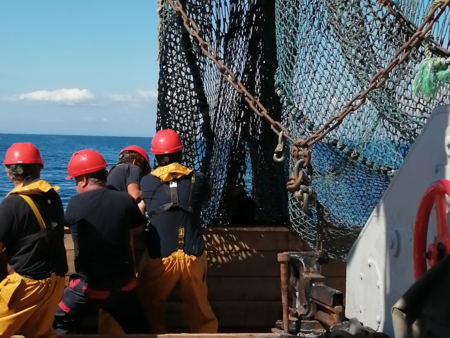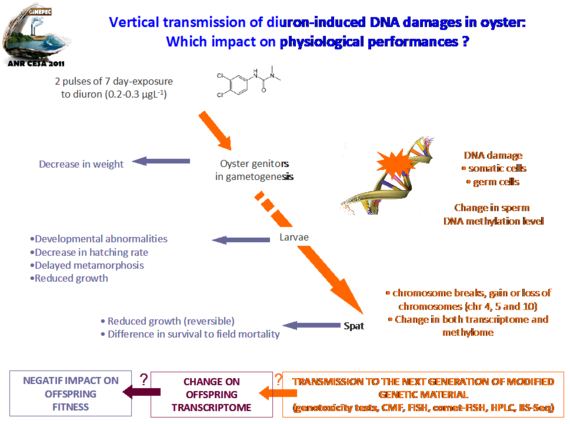GIMEPEC (2012-2015)
Role of chemical contamination in oyster summer mortality outbreaks
Study of the vertical transmission of diuron-induced DNA damage and its consequences on oyster physiology
This fundamental research project was coordinated by the laboratory of Ecotoxicology from Ifremer in Nantes (Dr F. Akcha). It was realized in collaboration with 4 joint research units [UMR IHPE, BOREA, LEMAR, ASIM (ex-LGP)], an university laboratory (LEMA) and a Canadian partner (INRS Montréal). The project started the 5th of January 2012 for 47 months 03/12/2015. It received 550000€ from the ANR for a total cost of 1723630€.
GIMEPEC aimed to study the potential role of chemical contamination in oyster mortality outbreaks. These mortalities are recurrent in France during the summer months and have serious socio-economic consequences. The hypothesis developed in the framework of the GIMEPEC project is that exposure of oysters to phytosanitary substances could be responsible of damage to the genetic material of oyster with consequences on its fitness (growth, reproduction, immunity, survival to pathogens). Because DNA is considered as a potential target for pesticides, the vertical transmission of DNA damages has been particularly investigated. The main goal of the project was to try to establish linkages between structural DNA damage, genome expression and decrease in biological performances.
Toxic effects of diuron in oyster and its offspring : use of advanced experimental infrastructure and molecular and cellular analysis tools
The experiments were conducted at the hatchery of Ifremer La Tremblade. Toxic effects of diuron were assessed in exposed genitors but also in larvae and spat originating from either the parental exposure or diuron-exposed embryos.
DNA lesions were measured by the comet assay, flow cytometry and immunohistochemistry. In the case of parental exposure, in situ hybridization and a comet-FISH protocol were applied in the offspring for the detection of damage in some of oyster chromosomes. The effects on oyster transcriptome and methylome were also assessed by RNA-seq and qPCR and HPLC-UV and BS-seq respectively. In genitors and larvae, the activities of some detoxification enzymes were measured by spectro-fluorimetry. Histological and radio-immunological analysis and flow cytometry were used to study the effects on reproduction and cell immunity parameters. The effect of diuron exposure on genes involved in key functions during gametogenesis was assessed by qPCR.
Oyster genitors in gametogenesis were in situ transplanted in order to allow a comparison with the results obtained at the experimental hatchery.
Chemical analysis were performed to measure the exposure levels reached at the hatchery and pesticide concentrations in the field (POCIS).
Main results
Among results, diuron genotoxicity was demonstrated in oysters exposed during gametogenesis to environmental concentrations. Structural DNA lesions were detected in somatic and germ cells. Analysis of the offspring revealed the transmission to the next generation of modified genetic material via the gametes. Chromosomal abnormalities as well as change in both the transcriptome and methylome of the offspring were also detected (Figure 1). Such genome alterations in the offspring were concomitantly observed with developmental abnormalities and growth delay in larvae and reversible growth delay and reduced field survival in spat. Our results demonstrated the possibility for diuron to have genotoxic and epigenetic effects. The presence of DNA damage was shown to interact with DNA methylation activities. Exposure to genotoxic pollutants can thus interfere with the mechanisms involved in specie adaptation to chemical stress and environmental changes.
Figure 1: Synthesis of the main results of the GIMEPEC project
Akcha Farida, Barranger Audrey, Bachère Evelyne (2021). Genotoxic and epigenetic effects of diuron in the Pacific oyster: in vitro evidence of interaction between DNA damage and DNA methylation. Environmental Science and Pollution Research, 28(7), 8266-8280. Publisher's official version: https://doi.org/10.1007/s11356-020-11021-6, Open Access version: https://archimer.ifremer.fr/doc/00654/76604/
Bachere Evelyne, Barranger Audrey, Bruno Roman, Rouxel Julien, Menard Dominique, Piquemal David, Akcha Farida (2017). Parental diuron-exposure alters offspring transcriptome and fitness in Pacific oyster Crassostrea gigas. Ecotoxicology and Environmental Safety, 142, 51-58. Publisher's official version: https://doi.org/10.1016/j.ecoenv.2017.03.030, Open Access version: https://archimer.ifremer.fr/doc/00380/49106/
Rondon Sallan Rodolfo, Grunau Christoph, Fallet Manon, Charlemagne Nicolas, Sussarellu Rossana, Chaparro Cristian, Montagnani Caroline, Mitta Guillaume, Bachere Evelyne, Akcha Farida, Cosseau Celine (2017). Effects of a parental exposure to diuron on Pacific oyster spat methylome. Environmental Epigenetics, 3(1), 13p. Publisher's official version: https://doi.org/10.1093/eep/dvx004 , Open Access version: https://archimer.ifremer.fr/doc/00602/71413/
Behrens Daphne, Rouxel Julien, Burgeot Thierry, Akcha Farida (2016). Comparative embryotoxicity and genotoxicity of the herbicide diuron and its metabolites in early life stages of Crassostrea gigas: implication of reactive oxygen species production. Aquatic Toxicology, 175, 249-259. Publisher's official version: https://doi.org/10.1016/j.aquatox.2016.04.003 , Open Access version: https://archimer.ifremer.fr/doc/00324/43521/
Rondon R., Akcha Farida, Alonso P., Menard Dominique, Rouxel Julien, Montagnani Caroline, Mitta Guillaume, Cosseau C., Grunau C. (2016). Transcriptional changes in Crassostrea gigas oyster spat following a parental exposure to the herbicide diuron. Aquatic Toxicology, 175, 47-55. Publisher's official version: https://doi.org/10.1016/j.aquatox.2016.03.007, Open Access version: https://archimer.ifremer.fr/doc/00318/42938/
Akcha Farida, Barranger Audrey, Bachere Evelyne, Berthelin C. Heude, Piquemal D., Alonso P., Sallan R. Rondon, Dimastrogiovanni G., Porte C., Menard Dominique, Szczybelski A., Benabdelmouna Abdellah, Auffret M., Rouxel Julien, Burgeot Thierry (2016). Effects of an environmentally relevant concentration of diuron on oyster genitors during gametogenesis: responses of early molecular and cellular markers and physiological impacts. Environmental Science and Pollution Research, 23(8), 8008-8020. Publisher's official version: https://doi.org/10.1007/s11356-015-5969-2 , Open Access version: https://archimer.ifremer.fr/doc/00309/41983/
Barranger Audrey, Heude-Berthelin Clothilde, Rouxel Julien, Adeline Beatrice, Benabdelmouna Abdellah, Burgeot Thierry, Akcha Farida (2016). Parental exposure to the herbicide diuron results in oxidative DNA damage to germinal cells of the Pacific oyster Crassostrea gigas. Comparative Biochemistry and Physiology C-toxicology & Pharmacology, 180, 23-30. Publisher's official version: https://doi.org/10.1016/j.cbpc.2015.11.002 , Open Access version: https://archimer.ifremer.fr/doc/00295/40655/
Perez Garcia Maria Concepcion, Rouxel Julien, Akcha Farida (2015). Development of a comet-FISH assay for the detection of DNA damage in hemocytes of Crassostrea gigas. Aquatic Toxicology, 161, 189-195. Publisher's official version: https://doi.org/10.1016/j.aquatox.2015.01.022, Open Access version: https://archimer.ifremer.fr/doc/00250/36157/
Barranger Audrey, Benabdelmouna Abdellah, Degremont Lionel, Burgeot Thierry, Akcha Farida (2015). Parental exposure to environmental concentrations of diuron leads to aneuploidy in embryos of the Pacific oyster, as evidenced by fluorescent in situ hybridization. Aquatic Toxicology, 159, 36-43. Publisher's official version: https://doi.org/10.1016/j.aquatox.2014.11.011, Open Access version: https://archimer.ifremer.fr/doc/00238/34911/
Barranger Audrey, Akcha Farida, Rouxel Julien, Brizard Raphael, Maurouard Elise, Pallud Marie, Menard Dominique, Tapie N., Budzinski Helene, Burgeot Thierry, Benabdelmouna Abdellah (2014). Study of genetic damage in the japanese oyster induced by an environmentally-relevant exposure to diuron: evidence of vertical transmission of DNA damage. Aquatic Toxicology, 146, 93-104. Publisher's official version: https://doi.org/10.1016/j.aquatox.2013.10.032, Open Access version: https://archimer.ifremer.fr/doc/00162/27311/
For more information, please contact: Farida.Akcha@ifremer.fr



